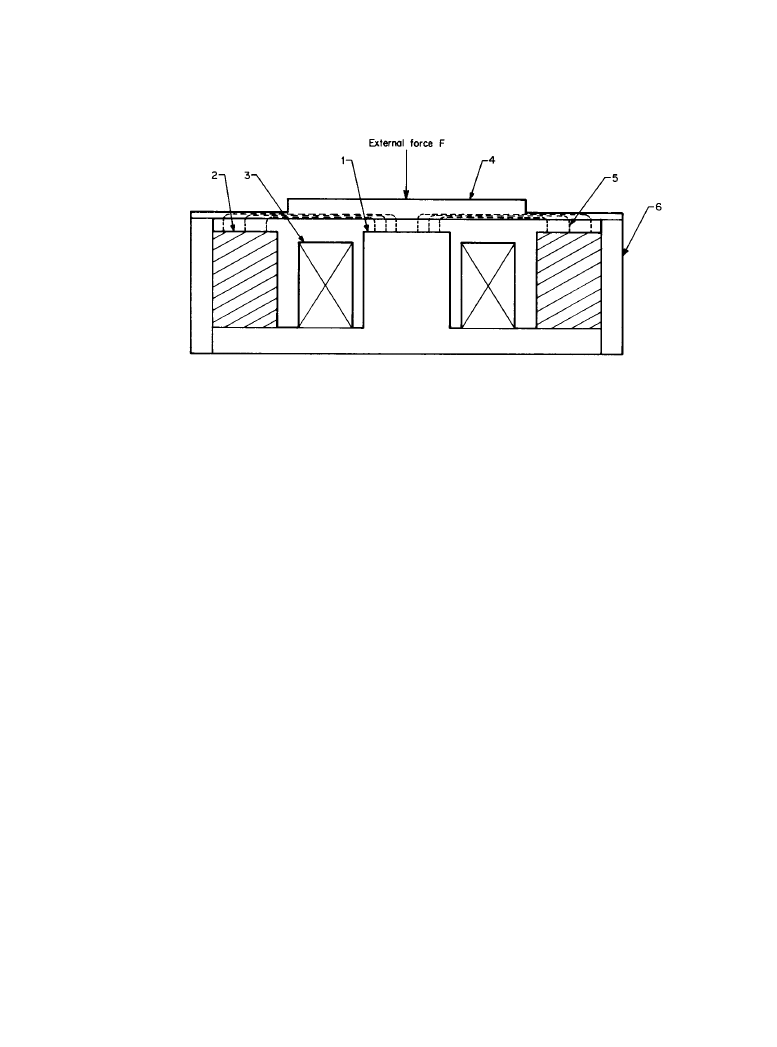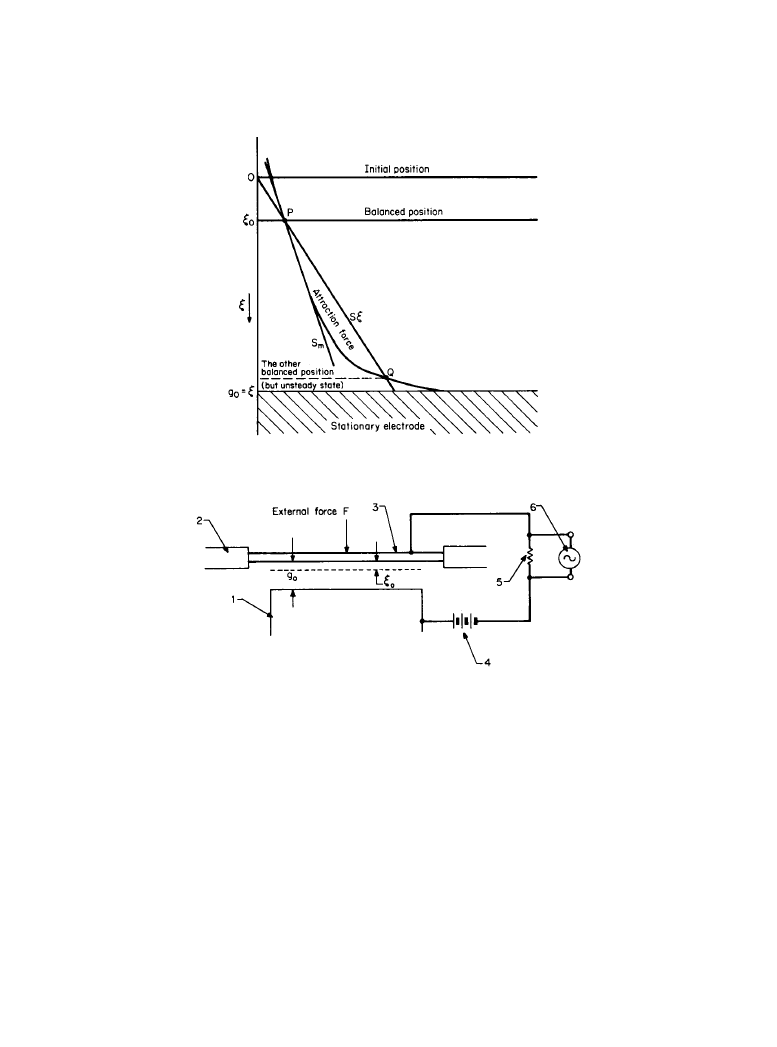ВУЗ: Казахская Национальная Академия Искусств им. Т. Жургенова
Категория: Книга
Дисциплина: Не указана
Добавлен: 03.02.2019
Просмотров: 21661
Скачиваний: 19

Electroacoustic Transducers 5-7
In the electrical system, assuming the electrical impedance of the driving coil to be Z
e
the
total voltage at the coil terminals corresponds to a summation of E and E
d
, whereby the follow-
ing equation is obtained
(5.1.5)
Where:
E = voltage applied across coil terminals (V)
Z
e
= electrical impedance of coil (
Ω)
When Equation (5.1.2) is substituted, E is determined by
(5.1.6)
Thus, Equations (5.1.4) and (5.1.6) are basic equations of the dynamic mechanical-electrical
systems.
5.1.2a
Basic Equations and Features of Electromagnetic Transducers
For an electromagnetic transducer, a magnetic diaphragm placed in a static magnetic field, in
which a permanent magnet supplies the steady magnetic flux, is vibrated in an ac magnetic field
formed by signal current flowing into a coil, thus generating a sound. This principle is shown in
Figure 5.1.2. In this figure, assume that the diaphragm is subjected to attraction force F
m
by the
static magnetic field and the external force F. At this time, the diaphragm vibrates from a sum-
mation of static displacement
ξ
s
by the attraction force in the static magnetic field and by the
dynamic displacement generated by an ac magnetic field and external force F. Assuming this to
be
ξ , ξ is expressed by
E
E
d
+
Z
e
I
=
E
Z
e
I
A
υ
+
=
Figure 5.1.2
Simplified form of an electromagnetic transducer. 1 = pole piece; 2 = permanent
magnet; 3 = drive coil; 4 = diaphragm; 5 = magnet flux; 6 = frame.
Downloaded from Digital Engineering Library @ McGraw-Hill (www.digitalengineeringlibrary.com)
Copyright © 2004 The McGraw-Hill Companies. All rights reserved.
Any use is subject to the Terms of Use as given at the website.
Electroacoustic Transducers

5-8 Sound Reproduction Devices and Systems
(5.1.7)
Where:
ξ = total displacement, m
ξ
s
= static displacement, m
ξ
d
= dynamic displacement, m
Assuming the equivalent circuit of the mechanical system of the diaphragm to be a single-res-
onance circuit with the number of degrees of freedom equal to 1, it may be regarded as being
composed of the lumped constant of equivalent mass, the mechanical resistance, and the stiffness
s. Therefore, from force-balanced conditions, the following is established
(5.1.8)
Where:
F = external force, N
F
m
= attraction force by static magnetic field, N
m = equivalent mass, kg
r = mechanical resistance, N/m
s = stiffness, Ns/m
If the resistance is ignored, since it is quite negligible compared with magnetic resistance in
the air space, the following relation is obtained
(5.1.9)
(5.1.10)
(5.1.11)
(5.1.12)
(5.1.13)
(5.1.14)
(5.1.15)
ξ
ξ
s
ξ
d
+
=
F
F
m
+
m∂
2
ξ
∂t
2
---------
r∂ξ
∂t
-------
s
ξ
+
+
=
Z
m
r
j
ωm j s s
n
–
(
)/ω
–
+
=
A
µ
0
s
n
U
0
/g
0
2
=
s
n
µ
0
SU
0
2
/g
0
2
=
Z
e
Z
c
j
ωL
m
+
=
L
m
µ
0
n
2
S/g
0
=
F
Z
m
v
AI
–
=
E
Z
e
I
Av
+
=
Downloaded from Digital Engineering Library @ McGraw-Hill (www.digitalengineeringlibrary.com)
Copyright © 2004 The McGraw-Hill Companies. All rights reserved.
Any use is subject to the Terms of Use as given at the website.
Electroacoustic Transducers

Electroacoustic Transducers 5-9
Where:
Z
m
= mechanical impedance of the vibrating system, mechanical ohms
ω = angular frequency, rad/s
A = force factor, N/A
s
n
= negative stiffness, Ns/m
L
m
= inductance, H
Φ = total magnetic flux in space, Wb
B = flux density, Wb/m
2
µ
0
= magnetic permeability in space, H/m
U
m
= magnetic motive force of magnet, A/m
S = magnetic-pole area, m
2
g
0
= quiescent space length in magnetic-force-free conditions, m
n = number of coil windings, turns
I = current flowing into coil, A
Z
c
= coil electrical impedance,
Ω
The difference between this transducer and the magnetic or dynamic transducer, in addition to
the gap, is that negative stiffness in Equation (5.1.11) is generated. This stable condition is as fol-
lows
(5.1.16)
where R
air
2
= magnetic resistance out of the air space, A/m. This relationship is shown in Figure
5.1.3. Other differences are that because the coil is fixed, reliability is high and construction is
simple, and that if the frequency is high, the force factor becomes small because of the coil
inductance, thereby reducing efficiency.
5.1.2b
Basic Equations and Features of Electrostatic Transducers
In the electrostatic transducer, when voltage is applied to two opposite conductive electrodes, an
electrostatic attraction force is generated between them, and the action of this force causes a con-
ductive diaphragm to be vibrated, thereby emitting sound. Figure 5.1.4 shows the construction.
Electrostatic attraction force F
s
, when signal voltage E is applied to polarized E
0
, is
(5.1.17)
Where:
F = static attraction force, N
ε
0
= dielectric constant, F/m
S = electrode area, m
2
E
0
= polarized voltage, V
E = signal voltage, V
g
0
= interelectrode distance, m
s
U
0
/
<
2
µ
0
S
0
g
0
R
air
2
F
ε
0
S E
0
E
+
(
)
2
2 g
0
ξ
0
–
ξ
d
–
(
)
2
-----------------------------------------
=
Downloaded from Digital Engineering Library @ McGraw-Hill (www.digitalengineeringlibrary.com)
Copyright © 2004 The McGraw-Hill Companies. All rights reserved.
Any use is subject to the Terms of Use as given at the website.
Electroacoustic Transducers

5-10 Sound Reproduction Devices and Systems
ξ
s
= static displacement, m
ξ
d
= signal displacement, m
Considering the correspondence between electromagnetic and electrostatic types, Equation
(5.1.17) is as shown in Table 5.1.1.
The basic equations of the electrostatic type are
(5.1.18)
s
n
ε
0
SE
0
2
/g
0
3
=
Figure 5.1.3
Static displacement shows balancing the attraction and the recover force.
Figure 5.1.4
Cross-sectional view of an electroacoustic transducer. 1 = back electrode; 2 = clamp-
ing ring; 3 = diaphragm with electrode; 4 = polarizing power supply; 5 = polarizing electrical resis-
tance; 6 = signal source.
Downloaded from Digital Engineering Library @ McGraw-Hill (www.digitalengineeringlibrary.com)
Copyright © 2004 The McGraw-Hill Companies. All rights reserved.
Any use is subject to the Terms of Use as given at the website.
Electroacoustic Transducers

Electroacoustic Transducers 5-11
(5.1.19)
(5.1.20)
(5.1.21)
(5.1.22)
(5.1.23)
Where:
Z
m
= mechanical impedance of the vibrating system, mechanical ohms
Y
s
= electrical admittance of electrostatic capacity before displacement
F = external force, N
I = current, A
s
n
= negative stiffness, N/m
A = force factor, N/V
r = mechanical resistance, Ns/m
m = mass, kg
s = diaphragm stiffness, N/m
ω = angular frequency, rad/s
Equations (5.1.22) and (5.1.23) are basic equations of the electrostatic transducer. Sensitivity
of this transducer can be obtained by increasing the polarized voltage and reducing the distance
between electrodes. Since the electrostatic type, unlike the electromagnetic type, has nothing to
restrict attraction force, the force of the diaphragm to stick to the electrode is infinite. Therefore,
the diaphragm requires a very large stiffness. Electrical impedance decreases inversely propor-
tionally to the frequency since it is quantitative. This type is simply constructed, and since it has
relatively good characteristics, it is used for high-range speakers and headphones.
5.1.2c
Basic Equations and Features of Piezoelectric Transducers
If a crystal section is distorted with a force applied in one direction, positive and negative
charges appear on the opposite surfaces of the crystal. This is called the piezoelectric direct
effect. When a field is applied to the crystal section from the outside, a mechanically distorted
force is generated. This is a piezoelectric counter effect. Ferrodielectric substances, which
exhibit such a phenomenon, are polarized. These include crystal, piezoelectric crystals such as
Rochelle salts, titanium oxide, and lead zirconate titanate (PZT). In general, PZT, having high
A
ε
0
SE
0
/g
0
2
=
Z
m
r
j
ωm j s s
n
–
(
)/ω
–
+
=
Y
s
j
ω ε
0
S/g
0
(
)
=
F
Z
m
υ AE
–
=
I
Y
s
E
A
υ
+
=
Table 5.1.1 Correspondence Between Electromagnetic and Electrostatic Types
Electromagnetic
nI
U
0
µ
0
F
m
Φ
Electrostatic
E
E
0
ε
0
F
s
q
Downloaded from Digital Engineering Library @ McGraw-Hill (www.digitalengineeringlibrary.com)
Copyright © 2004 The McGraw-Hill Companies. All rights reserved.
Any use is subject to the Terms of Use as given at the website.
Electroacoustic Transducers